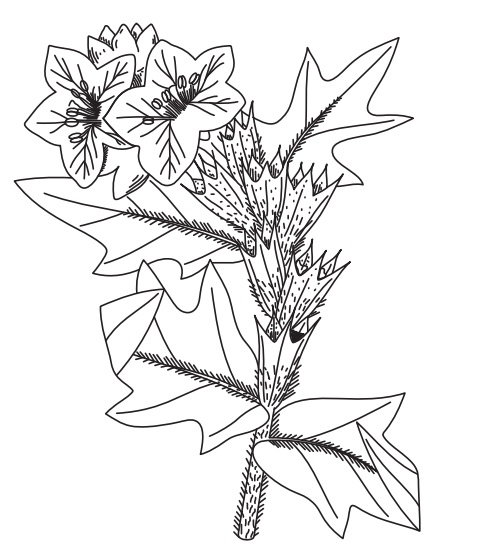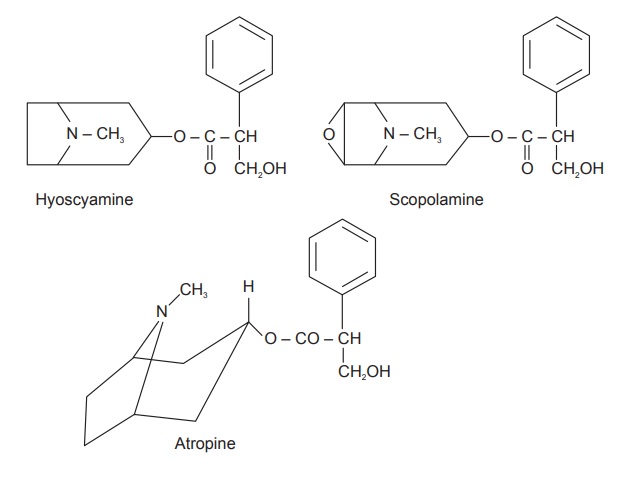Hyoscyamus
| Home | | Pharmacognosy |Chapter: Pharmacognosy and Phytochemistry : Drugs Containing Alkaloids
Hyoscyamus consists of the dried leaves and flowering tops of Hyoscyamus niger Linn., belonging to family Solanaceae. It contains not less than 0.05% alkaloids, calculated as hyoscyamine.
HYOSCYAMUS
Synonyms
Common Henbane, Hyoscyamus, Hog’s-bean, Jupiter’s-bean,
Symphonica, Cassilata, Cassilago, Deus Caballinus.
Biological Source
Hyoscyamus consists of the dried leaves and flowering tops
of Hyoscyamus niger Linn., belonging to family Solanaceae. It contains not less
than 0.05% alkaloids, calculated as hyoscyamine.
Geographical Source
It is found throughout Central and Southern Europe and in
Western Asia, extending to India and Siberia. As a weed of cultivation it now
grows also in North America and Brazil. Apart from these countries, it grows in
Scotland, England and Wales and also in Ireland, and has been found wild in 60
British countries.
History
The medicinal uses of Henbane date from Ancients times,
being particularly commended by Dioscorides (first century A.D.), who used it
to procure sleep and allay pains, and Celsus (same period) and others made use
of it for the same purpose, internally and externally. This use is mentioned in
a work by Benedictus Crispus (A.D. 681) under the names of Hyoscyamus and
Symphonica. There is frequent mention made of it in Anglo Saxon works on
medicine of the eleventh century, in which it is named ‘Henbell’, and in the
old glossaries of those days it also appears as Caniculata, Cassilago and Deus
Caballinus
Later it was not used. It was omitted from the London
Pharmacopoeia of 1746 and 1788, and only restored in 1809; its reintroduction
being chiefly due to experiments and recommendations by Baron Storch, who gave
it in the form of an extract, in cases of epilepsy and other nervous and
convulsive diseases.
Cultivation and Collection
Drug is usually obtained from cultivated biennial herb.
Henbane will grow on most soils, in sandy spots near the sea, on chalky slopes,
and in cultivation flourishing in a good loam, It requires a light, moderately
rich and well-drained soil for successful growth and an open, sunny situation,
but does not want much attention beyond keeping the ground free from weeds. The
seed should be sown in the open, early in May or as soon as the ground is warm,
as thinly as possible, in rows 2–2.5 feet apart, the seedlings thinned out to 2
feet apart in the rows, as they do not stand transplanting well. In order to
more readily ensure germination, it is advisable to soak the seeds in water for
24 h before planting the unfertile seeds will then float on the top of the
water and may thus be distinguished. Ripe seed should be grey, and yellowish or
brown seeds should be rejected, as they are immature. Let the seeds dry and
then sift out the smallest, using only the larger seeds. Only the larger
seedlings should be reserved, especially those of a bluish tint. The soil where
the crop is to be, must have been well manured, and must be kept moist until
the seeds have germinated, and also during May and June of the first year. It
is also recommended to sow seeds of biennial Henbane at their natural ripening
time, August, in porous soil.
The ground must never be water-logged, drought and late
frosts stunt the growth and cause it to blossom too early, and if the climatic
conditions are unsuitable, espe-cially in a dry spring and summer, the biennial
Henbane will flower in its’ first year, while the growth is quite low, but well
manured soil may prevent this. Much of the efficacy of Henbane depends upon the
time at which it is gathered. The leaves should be collected when the plant is
in full flower. In the biennial plant, those of the second year are preferred
to those of the first; the latter are less clammy and foetid, yield less
extractive, and are medici-nally considered less efficient. The leaves of the
biennial variety are collected in June or the first week of July and those of
the annual in August. They are dried at 40–50°C in drying sheds, heated from
outside. The dried drug is stored in airtight containers at low temperature,
protected from light and moisture.
Characteristics
Both varieties are used in medicine, but the biennial form
is the one considered official. The leaves of this biennial plant spread out
flat on all sides from the crown of the root like a rosette; they are oblong
and egg-shaped, with acute points, stalked and more or less sharply toothed,
often more than a foot in length, of a greyish-green colour and covered with
sticky hairs. These leaves perish at the appearance of winter. The flowering
stem pushes up from the root-crown in the following spring, ultimately reaching
from 3 to 4 feet in height, and as it grows, becoming branched and furnished
with alternate, oblong, unequally lobed, stalk-less leaves, which are
stem-clasping and vary considerably in size, but seldom exceed 9–10 inches in
length. These leaves are pale green in colour, with a broad conspicuous midrib,
and are furnished on both sides (but particularly on the veins of the under
surface) with soft, glandular hairs, which secrete a resinous substance that
causes the fresh leaves to feel unpleasantly clammy and sticky. Similar hairs
occur on the sub-cylindrical branches.
The flowers are shortly stalked, the lower ones growing in
the fork of the branches, the upper ones stalkless, crowded together in one
side, leafy spikes, which are rolled back at the top before flowering, the
hairy, leafy, coarsely toothed bracts becoming smaller upwards. The flowers
have a hairy, pitcher shaped calyx, which remains round the fruit and is
strongly veined, with five stiff, broad, almost prickly lobes. The corollas are
obliquely funnel-shaped, upwards of an inch across, of a dingy yellow or buff,
marked with a close network of lurid purple veins. A variety sometimes occurs
in which the corolla is not marked with these purple veins. The seed-capsule
opens transversely by a convex lid and contains numerous small seeds.

Microscopy
The epidermis is covered with smooth layer of cuticle.
Epidermis has slightly sinuous anticlinal walls and has covering and glandular
trichomes along with anisocytic type of stomata. The covering trichomes are
uni-seriate, multicellular with two to four-celled, and the glandular
trichomes have uni-seriate stalk with two to six cells and ovoid multicellular
glandular head. The mesophyll is usually dorsiventral with single layer of
palisade parenchymatous cells only below the upper epidermis and rarely
isobilateral. A crystal layer is present below the palisade, with tetragonal
prisms or clusters of few components. In the midrib region it has long narrow
arc of radially arranged xylem above the phloem and an endodermis consisting of
starch. The remaining portion is covered with parenchyma with small
supernumerary phloem.
The transverse section of stem shows a large central hollow
and consists of numerous perimedullary phloem bundles in the pith region.
Tetragonal calcium oxalate as prisms or clusters or in micro-sphenoidal sandy
shape is also present in the pith.
Chemical Constituents
The chief constituent of Henbane leaves is the alkaloid
Hyoscyamine, together with smaller quantities of Atropine and Hyoscine, also
known as Scopolamine, The proportion of alkaloid in the dried drug varies from
0.045% to 0.14%. Other constituents of Henbane are a glucosidal bitter
principle called hyoscytricin, choline, mucilage, albumin, calcium oxalate and
potassium nitrate. On incineration, the leaves yield about 12% of ash. The
chief constituent of the seeds is about 0.5–0.6% of alkaloid, consisting of
Hyoscyamine, with a small proportion of Hyoscine, The seeds also contain about
20% of fixed oil.

Uses
It is used as antispasmodic, hypnotic and mild diuretic. The
leaves have long been employed as a narcotic medicine. It is similar in action
to belladonna and stramonium, though milder in its effects. The drug combines
the therapeutic actions of its two alkaloids, hyoscyamine and hyoscine. Because
of the presence of the former, it tends to check secretion and to relax spasms
of the involuntary muscles, while through the narcotic effects of its hyoscine
it lessens pain and exercises a slight somnifacient action. It will also
relieve pain in cystitis. It is used to relieve the griping caused by drastic
purgatives, and is a common ingredient of aperient pills, especially those
containing aloes and colocynth.
Marketed Products
It is one of the ingredients of the preparations known as
Muscle and joint rub (Himalaya Drug Company), Brahmi vati, Sarpagandhaghan Vati
(Dabur) and Zymnet drops (Aimil Pharmaceuticals).
